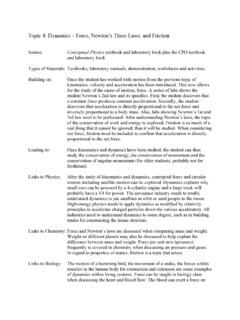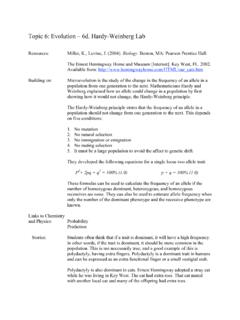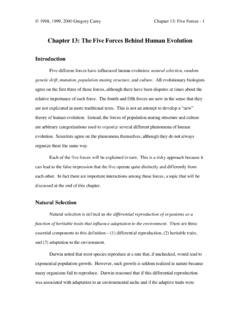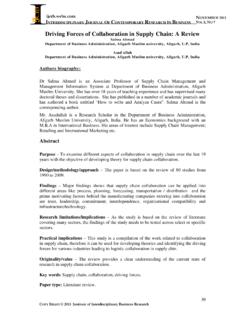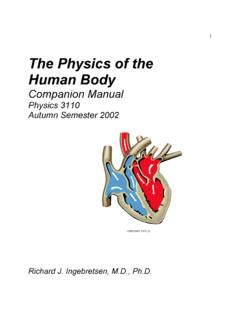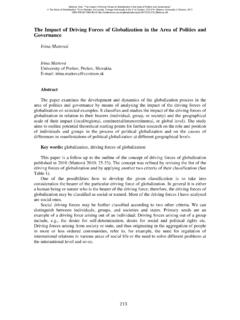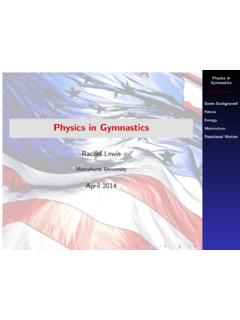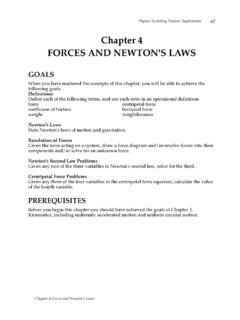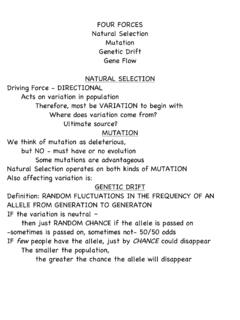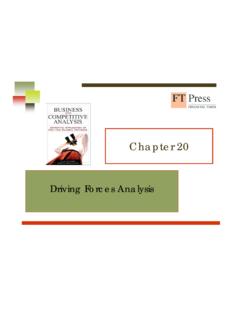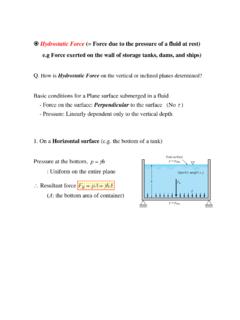Transcription of Physics of Dance - Fermilab
1 4/16/2003 Natalia KuznetsovaFermilab1 Physics of DancePhysics of Dance Basic Physics definitions we ll need Balance Turns Jumps Why are dancers so slim? The Physics behind the body size!4/16/2003 Natalia KuznetsovaFermilab2 Basic Physics definitions we ll needBasic Physics definitions we ll need VelocityVelocityis how fast and in what direction an object is moving It's basically rate = distance/time + direction MomentumMomentumis mass times velocity If an object has a large momentum, it s hard to stop it! ForceForceis basically a push or a pull To change an object s momentum, you have to apply some kind of force for some time! Sochange in momentum = force x duration of time the force was applied4/16/2003 Natalia KuznetsovaFermilab3A force is a vector quantityA force is a vector quantity A force is a vectorquantity, meaning that it has both magnitude and direction.
2 This is why forces are often graphically represented as arrows Forces add! It's the totaltotalforce that counts!gravity pushesdownwardstable pushesupwards4/16/2003 Natalia KuznetsovaFermilab4 What forces act on a dancer?What forces act on a dancer? Gravity (downwards) Support from floor (upwards) Friction from floor (sideways) Frictionis the force that resists relative motion between two bodies incontact Keith RobertsAmerican Ballet Theatre principal(photo by Roy Round)gravity floor support4/16/2003 Natalia KuznetsovaFermilab5 Some more Physics definitions: spinsSome more Physics definitions: spins Angular velocityAngular velocityis how fast an object spins It is also a vector, characterized not only by magnitude but also by the direction of the rotation axis.
3 Rotational inertiaRotational inertiais the inertia of a rotating object Inertiaingeneral is the tendency of an object to keep doing whatever it is doing Angular momentum Angular momentum is rotational inertiatimes angular velocity If an object has a large angular momentum,it's hard to stop its spinning! 4/16/2003 Natalia KuznetsovaFermilab6 TorqueTorque TorqueTorqueis a measure of how much a force acting on an object causes that object to rotate. You are applying a torque to doors every day of your life!change in angular momentum = torque x duration of time the torque was appliedFrTorque = distance (r) times force (F)4/16/2003 Natalia KuznetsovaFermilab7 AnalogiesAnalogiesMotion without spinsMotion with spinsVelocityVelocityMassMassMomentumMom entumForceForceAngular velocityAngular velocityRotational inertiaRotational inertiaAngular momentumAngular momentumTorqueTorque4/16/2003 Natalia KuznetsovaFermilab8 What's balance?
4 What's balance? No totalforce and no totaltorque No totalforce is needed so that the momentum does not change No totaltorque is required so that the angular momentum does not change4/16/2003 Natalia KuznetsovaFermilab9 Amazing examples of examples of Ballet Theatre principal(photo by Roy Round)4/16/2003 Natalia KuznetsovaFermilab10 Center of gravityCenter of gravity The center of gravity The center of gravity of an object is that point at which the object will balance. The entire weight may be considered as concentrated at this point, hence the 's center of gravity4/16/2003 Natalia KuznetsovaFermilab11A trick to know about center of gravityA trick to know about center of gravity In order to stay balanced, the center of gravity must remain directly above the area of contact with the floor!
5 Then gravity's downward push and floor's upward push will go through the dancer's center of gravity and there is no totalforce and no totaltorque If this area is very small( , a dancer is enpointe), it's harder to balance4/16/2003 Natalia KuznetsovaFermilab12 Balancing Balancing Ballet principal4/16/2003 Natalia KuznetsovaFermilab13 Area covered while Area covered while en pointeen pointeDemo with graph paper, KuznetsovaFermilab14 How can a Dance keep a balance while turning?How can a Dance keep a balance while turning? What's the trick that keeps the dancer balanced when she is turning? The rotation axis shouldn't wobble around much! There's a lot of neat Physics in turns!4/16/2003 Natalia KuznetsovaFermilab15 What describes turns?
6 What describes turns? The relevant quantities that describe turns are: Angular velocityAngular velocityis how fast an object spins Rotational inertiaRotational inertiais the inertia of a rotating object Angular momentum Angular momentum is rotational inertia times angular velocity A change in angular momentum is equal to the torquetorqueexerted on an object times the duration of time the torque was acting4/16/2003 Natalia KuznetsovaFermilab16 Rotational inertiaRotational inertia Rotational inertia indicates how difficult it is to start an object spinning (or to stop it, if it's already spinning) It depends on the mass of the object The greater the mass, the greater the rotational inertia It also depends on how far the mass of the object is placed fromthe rotation axis If this distance is doubled, the rotational inertia gets quadrupled!
7 If no torque is applied, the angular momentum stays the same So since angular momentum = rotational inertia times angular velocity, the greater the rotational inertia, the smaller the angular velocity!4/16/2003 Natalia KuznetsovaFermilab17 Rotational Inertia (2)Rotational Inertia (2) afterrr 24 rpm1 rpm The masses were at a distance r from the rotation axis before Then the distance doubled => rotational inertia quadrupled, so the angular velocity became smaller by a factor of four. A number of ballet movements is based on this KuznetsovaFermilab18 FouetteFouette1)Dancer starts turning --arms brought together(r small, rotational inertia small, so large angular velocity)2) Dancer stops for a moment by extending arms and leg(r large, rotational internal large, so small angular velocity)3)Dancer continues turning --arms brought together(r small, rotational inertia small, so large angular velocity)1122334/16/2003 Natalia KuznetsovaFermilab19 Friction can create torque, too!
8 Friction can create torque, too!When the dancer pushes the floor one way, the friction between the leg and the floor creates the push the other KuznetsovaFermilab20 The Physics of jumpsThe Physics of jumps Gravitational force plays a major role in jumps The totaleffect of gravity is the same as if it were acting on the dancer's center of gravity only Gravity only affects vertical (not horizontal) motion Gravitational force is proportional to an object's mass So double the mass, and the gravitational pull will double too!4/16/2003 Natalia KuznetsovaFermilab21 Horizontal vs. vertical motionHorizontal vs. vertical motion The vertical position of the dancer's center of gravity vs. time describes a parabola There's no force in the horizontal direction, so thehorizontal position is astraight line if we plot it vs.
9 Time timetimevertical positionhorizontal positiongoing upcoming down4/16/2003 Natalia KuznetsovaFermilab22 Trajectory in a jumpTrajectory in a jump2 ft ft2 ft ft If a dancer jumps so that their center of gravity rises by 2 feet, and the horizontal velocity is 10 ft/sec, this is what we would KuznetsovaFermilab23 Floating?Floating? While the trajectory is always the same, some dancers can create an illusion of floating in space. This is done by raising the legs, arms, adjusting the head The vertical motion of the head is smaller than the vertical motion of the center of gravity 4/16/2003 Natalia KuznetsovaFermilab24 Beautiful jumpsBeautiful jumpsYulia MakhalinaFarukh RuzimatovKirovBallet principals(photo by MarcHaegeman) 4/16/2003 Natalia KuznetsovaFermilab25 Body size effectsBody size effects Rotational inertia is proportional to the mass of an object and to the square of the distance from the rotation axis to the object s edge In order to rotate faster, need to decrease rotational inertia This can be done in two ways.
10 Decrease mass Make sure most of the body is very close to the rotation axis Most dancers go for 4/16/2003 Natalia KuznetsovaFermilab26A dancer's body evolutionA dancer's body evolution It is curious to see how the way dancers look changed over time Increased technical demands required new body looks And it's nothing but Physics that's behind it!Pierina Legnani(1863 -1923).Sylvie GuillemRoyal Ballet Principal4/16/2003 Natalia KuznetsovaFermilab27 Never exaggerate!Never exaggerate! Sometimes the demand for a perfect dancer's body leads to really ugly KuznetsovaFermilab28 Conclusions and acknowledgementsConclusions and acknowledgements Physics does not "explain" Dance , of course! Dance is an art form, and as such is rather outside the realm ofscience However, it may help the dancer to know the Physics behind the movements she is performing.
